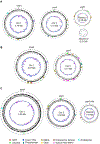Burkholderia as a Source of Natural Products
- PMID: 31294966
- PMCID: PMC6871192
- DOI: 10.1021/acs.jnatprod.8b01068
Burkholderia as a Source of Natural Products
Abstract
Burkholderia bacteria are multifaceted organisms that are ecologically and metabolically diverse. The Burkholderia genus has gained prominence because it includes human pathogens; however, many strains are nonpathogenic and have desirable characteristics such as beneficial plant associations and degradation of pollutants. The diversity of the Burkholderia genus is reflected within the large genomes that feature multiple replicons. Burkholderia genomes encode a plethora of natural products with potential therapeutic relevance and biotechnological applications. This review highlights Burkholderia as an emerging source of natural products. An overview of the taxonomy of the Burkholderia genus, which is currently being revised, is provided. We then present a curated compilation of natural products isolated from Burkholderia sensu lato and analyze their characteristics in terms of biosynthetic class, discovery method, and bioactivity. Finally, we describe and discuss genome characteristics and highlight the biosynthesis of a select number of natural products that are encoded in unusual biosynthetic gene clusters. The availability of >1000 Burkholderia genomes in public databases provides an opportunity to realize the genetic potential of this underexplored taxon for natural product discovery.
Figures












Similar articles
-
Genome-guided discovery of diverse natural products from Burkholderia sp.J Ind Microbiol Biotechnol. 2014 Feb;41(2):275-84. doi: 10.1007/s10295-013-1376-1. Epub 2013 Nov 9. J Ind Microbiol Biotechnol. 2014. PMID: 24212473 Free PMC article. Review.
-
The Hidden Genomic Diversity, Specialized Metabolite Capacity, and Revised Taxonomy of Burkholderia Sensu Lato.Front Microbiol. 2021 Sep 22;12:726847. doi: 10.3389/fmicb.2021.726847. eCollection 2021. Front Microbiol. 2021. PMID: 34650530 Free PMC article.
-
Heterologous Production of Lasso Peptide Capistruin in a Burkholderia Host.ACS Synth Biol. 2020 Feb 21;9(2):241-248. doi: 10.1021/acssynbio.9b00438. Epub 2020 Jan 13. ACS Synth Biol. 2020. PMID: 31913601 Free PMC article.
-
Genomics-Driven Discovery of Plantariitin A, a New Lipopeptide in Burkholderia plantarii DSM9509.Molecules. 2025 Feb 14;30(4):868. doi: 10.3390/molecules30040868. Molecules. 2025. PMID: 40005178 Free PMC article.
-
Biotechnology approaches for natural product discovery, engineering, and production based on Burkholderia bacteria.Curr Opin Biotechnol. 2022 Oct;77:102782. doi: 10.1016/j.copbio.2022.102782. Epub 2022 Aug 29. Curr Opin Biotechnol. 2022. PMID: 36049254 Free PMC article. Review.
Cited by
-
Isolation, complete genome sequencing and in silico genome mining of Burkholderia for secondary metabolites.BMC Microbiol. 2022 Dec 30;22(1):323. doi: 10.1186/s12866-022-02692-x. BMC Microbiol. 2022. PMID: 36581815 Free PMC article.
-
Discovery of Ubonodin, an Antimicrobial Lasso Peptide Active against Members of the Burkholderia cepacia Complex.Chembiochem. 2020 May 4;21(9):1335-1340. doi: 10.1002/cbic.201900707. Epub 2020 Jan 3. Chembiochem. 2020. PMID: 31765515 Free PMC article.
-
Rational construction of genome-reduced Burkholderiales chassis facilitates efficient heterologous production of natural products from proteobacteria.Nat Commun. 2021 Jul 23;12(1):4347. doi: 10.1038/s41467-021-24645-0. Nat Commun. 2021. PMID: 34301933 Free PMC article.
-
Development and application of an efficient recombineering system for Burkholderia glumae and Burkholderia plantarii.Microb Biotechnol. 2021 Jul;14(4):1809-1826. doi: 10.1111/1751-7915.13840. Epub 2021 Jun 30. Microb Biotechnol. 2021. PMID: 34191386 Free PMC article.
-
Genomics-Driven Activation of Silent Biosynthetic Gene Clusters in Burkholderia gladioli by Screening Recombineering System.Molecules. 2021 Jan 29;26(3):700. doi: 10.3390/molecules26030700. Molecules. 2021. PMID: 33572733 Free PMC article.
References
Publication types
MeSH terms
Substances
Grants and funding
LinkOut - more resources
Full Text Sources
Other Literature Sources
Molecular Biology Databases

